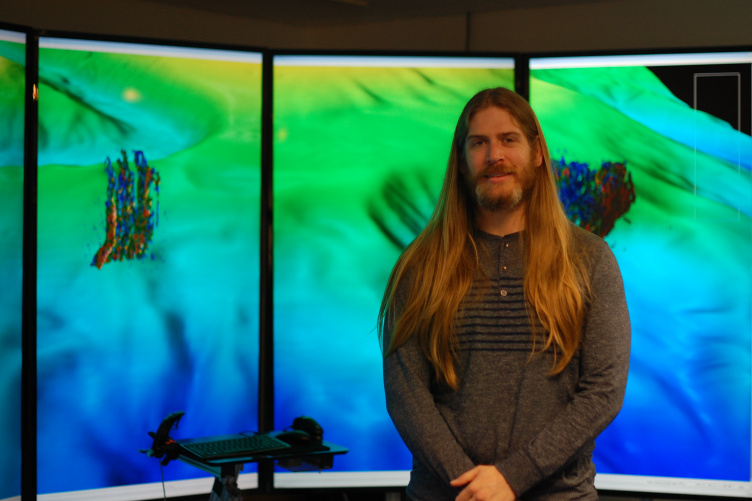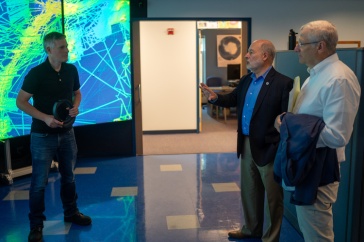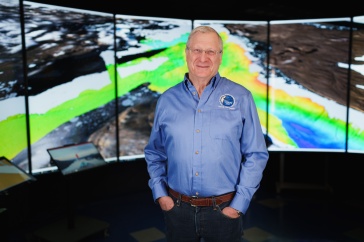
Drew Stevens
In a darkened room filled with gigantic computer screens, Drew Stevens '17G types on the keyboard and watches the results: A blade of kelp that appears three-dimensional begins moving as if it’s underwater, the shape morphing and flowing back and forth. Stevens points out where small crustaceans can hide in the moving kelp blades, thereby avoiding larger predators.
For Stevens, who is currently a doctoral student in computer science, this predator-prey research is fascinating. But what really intrigues him is the larger concept of data visualization — a method of showcasing information to help people more quickly assess complex patterns and trends in data. Data visualization is more than just scientific charts and graphs; it includes the complex computer codes Stevens wrote that resulted in the moving kelp on the computer screen, and it stretches as far as the virtual reality goggles he’s used to help the public learn about how computer science can improve the ways scientists study coral reefs.
“I came in as a music major with a science background, and CCOM provided the support I needed to focus on this new career trajectory."
Data visualization is a long way from Stevens’ background, though. With an undergraduate degree in music composition from The University of California, Davis and some experience working as an environmental consultant, he has a unique set of skills. But for students like Stevens who have multiple career interests and might be looking for a way to combine them, it turns out that UNH is a good place to be.
“I’m creative and I like computers, so I was looking for a way to blend those interests in graduate school,” he says. Enter the UNH Data Visualization Research Laboratory, where he began working in 2014 as an M.S. student in computer science. The Vis Lab, as it’s commonly called around campus, is part of the Center for Coastal and Ocean Mapping (CCOM) and is directed by Colin Ware.
“I came in as a music major with a science background, and CCOM provided the support I needed to focus on this new career trajectory,” Stevens says. “CCOM’s interdisciplinary focus helps to keep me from getting a myopic view of computer science — I have a better idea of how to apply computer science outside of theory by working with the practical applications of technology. And I use data from a variety of scientists, so I get to contribute to the research without having to be an expert in each domain,” he explains.

For example, as part of an interdisciplinary course between his M.S. and doctoral degrees, Stevens worked with the Superstorm Sandy Research Team at CCOM to create an interactive map of the storm’s marine debris. That information was relayed to the public in an “intuitive format,” Stevens says. More recently, Stevens ran an experiment to evaluate whether providing visuals in virtual reality which compensate for a ship’s movement on the ocean can decrease the potential for seasickness — the results were positive, he says.
Stevens has also been a fixture at outreach events like UNH’s Ocean Discovery Day, where he teaches students and adults about data visualization and lets them use a controller to explore a 3D coral reef model which was generated solely from video captured via a GoPro camera attached to a researcher’s dive mask.
“Public outreach is paramount so that people learn about all the great work we do,” he says. “I hope we can inspire the next generation and then get their parents involved, too. It’s great when they become interested in the topic and you can see them light up.”
Stevens is nearing the end of his doctoral program, but he credits the variety of projects, outreach opportunities and the interdisciplinary nature of the research as reasons why he’s likely to continue working with data visualization for a long time to come.
“CCOM has provided me with a unique opportunity for work, and I’ve had a great experience here,” he says. “It could not have turned out better.”
The Institute for the Study of Earth, Oceans, and Space (EOS) is UNH’s largest research enterprise, comprising six centers with a focus on interdisciplinary, high-impact research on Earth and climate systems, space science, the marine environment, seafloor mapping and environmental acoustics. With more than $43 million in external funding secured annually, EOS fosters an intellectual and scientific environment that advances visionary scholarship and leadership in world-class research and graduate education.
-
Written By:
Rebecca Irelan | Institute for the Study of Earth, Oceans, and Space | rebecca.irelan@unh.edu | 603-862-0990



















































